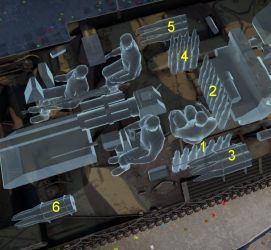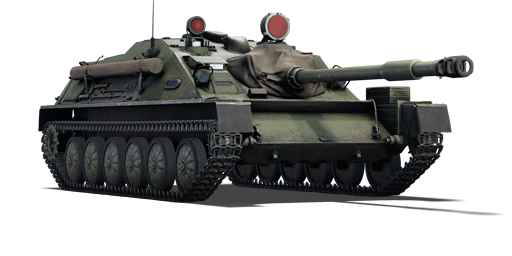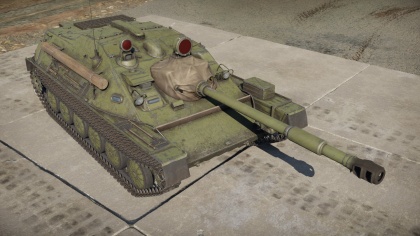Difference between revisions of "ASU-85"
CobraKingII (talk | contribs) (→Usage in battles) (Tag: Visual edit) |
(→Main armament) (Tag: Visual edit) |
||
| Line 68: | Line 68: | ||
! style="width:4em" |Prior + Ace qualif. | ! style="width:4em" |Prior + Ace qualif. | ||
|- | |- | ||
| − | | ''Arcade'' || 4.2 || | + | | ''Arcade'' || 4.2 ||8.5||10.4||11.5||12.2 |
|- | |- | ||
| − | | ''Realistic'' || 4.2 || | + | | ''Realistic'' || 4.2 ||4.9||6.0||6.6||7.0 |
|- | |- | ||
! colspan="4" | Reloading rate (seconds) | ! colspan="4" | Reloading rate (seconds) | ||
| Line 79: | Line 79: | ||
! colspan="1" style="width:4em" |Prior + Ace qualif. | ! colspan="1" style="width:4em" |Prior + Ace qualif. | ||
|- | |- | ||
| − | | 11.2 || | + | | 11.2 ||9.9||9.1||8.6 |
|- | |- | ||
|} | |} | ||
Revision as of 12:05, 21 May 2020
Contents
Description
The ASU-85 is a Rank IV Russian tank destroyer
with a battle rating of 6.3 (AB/RB/SB). It was introduced in Update 1.59 "Flaming Arrows". It was designed to provide the VDV (Vozdushno-Desantnye Voyska), the Soviet airborne forces, with an air-portable self-propelled gun for independent fire support and anti-tank capability in support of paratroopers during airborne operations.
General info
Survivability and armour
The front upper glacis plate, while only 45 mm thick, is quite heavily sloped and can occasionally ricochet rounds. The mantlet is also quite thick and rounded, and it can also bounce the occasional lucky shot.
However, the rest of the ASU-85 is very thinly armoured and vulnerable to even heavy machine guns. It is especially vulnerable to aircraft strafing.
Armour type:
- Rolled homogeneous armour
- Cast homogeneous armour (Gun mantlet)
| Armour | Front | Sides | Rear | Roof |
|---|---|---|---|---|
| Hull | 45 mm (60°) Front glacis 45 mm (37°) Lower glacis 50 mm Driver port |
6 mm | 6 mm (40°) Upper 6 mm (18°) Lower |
6 mm |
| Superstructure | 45 mm (60°) Front glacis 100 mm Gun mantlet |
13 mm (37-38°) | 6 mm | 13 mm Front 6 mm Rear |
Notes:
- Suspension wheels are 10 mm thick, tracks are 15 mm thick.
Mobility
| Game Mode | Max Speed (km/h) | Weight (tons) | Engine power (horsepower) | Power-to-weight ratio (hp/ton) | |||
|---|---|---|---|---|---|---|---|
| Forward | Reverse | Stock | Upgraded | Stock | Upgraded | ||
| Arcade | 49 | 6 | 15.9 | 298 | 401 | 18.74 | 25.22 |
| Realistic | 45 | 6 | 186 | 210 | 11.7 | 13.21 | |
It should also be noted that the ASU-85 is not amphibious, unlike the PT-76B it is based on.
Armaments
Main armament
The ASU-85 is armed with the 85 mm D-70, a significantly more powerful gun compared to the wartime Soviet 85 mm ZiS S-53 and D-5T guns and comparable in capability to the German 8,8 cm L/71 guns. The mounting has only 4° of gun depression due to the restricted size of the vehicle, but has a fairly generous amount of traverse for a casemate tank destroyer. It has a relatively low rate-of-fire for its calibre, reflecting the rather cramped crew compartment of the ASU-85.The standard shell is the BR-372 APBC shell with a lethal explosive filler. It has an excellent muzzle velocity and is accurate at long ranges. It will also easily penetrate most things that the ASU-85 may encounter. Anything that cannot be penetrated by the APBC shell will almost certainly be penetrable by the 3BK7 HEAT-FS round. Boasting 300 mm of penetration, it is capable of punching straight through a Tiger II's upper glacis and does not lose penetration over distance. However, it suffers the usual drawbacks of HEAT rounds (cannot go through obstacles like trees or fences) and is significantly less lethal than the APBC shell. The muzzle velocity is also lower, which can complicate aiming at long ranges.
| 85 mm D-70 | |||||
|---|---|---|---|---|---|
| Capacity | Vertical guidance |
Horizontal guidance |
Stabilizer | ||
| 39 | -4°/+15° | ±15° | N/A | ||
| Turret rotation speed (°/s) | |||||
| Mode | Stock | Upgraded | Prior + Full crew | Prior + Expert qualif. | Prior + Ace qualif. |
| Arcade | 4.2 | 8.5 | 10.4 | 11.5 | 12.2 |
| Realistic | 4.2 | 4.9 | 6.0 | 6.6 | 7.0 |
| Reloading rate (seconds) | |||||
| Stock | Prior + Full crew | Prior + Expert qualif. | Prior + Ace qualif. | ||
| 11.2 | 9.9 | 9.1 | 8.6 | ||
Ammunition
| Penetration statistics | |||||||
|---|---|---|---|---|---|---|---|
| Ammunition | Type of warhead |
Penetration in mm @ 0° Angle of Attack | |||||
| 10m | 100m | 500m | 1000m | 1500m | 2000m | ||
| BR-372 | APBC | 230 | 227 | 214 | 199 | 186 | 172 |
| OF-372 | HE | 11 | 11 | 11 | 11 | 11 | 11 |
| 3BK7 | HEATFS | 300 | 300 | 300 | 300 | 300 | 300 |
| Shell details | ||||||||||
|---|---|---|---|---|---|---|---|---|---|---|
| Ammunition | Type of warhead |
Velocity in m/s |
Projectile Mass in kg |
Fuse delay
in m: |
Fuse sensitivity
in mm: |
Explosive Mass in g (TNT equivalent): |
Normalization At 30° from horizontal: |
Ricochet: | ||
| 0% | 50% | 100% | ||||||||
| BR-372 | APBC | 1040 | 9.3 | 1.2 | 15 | 85 | +4° | 48° | 63° | 71° |
| OF-372 | HE | 1010 | 9.7 | 0.1 | 0.3 | 740 | +0° | 79° | 80° | 81° |
| 3BK7 | HEATFS | 925 | 7.2 | 0.1 | 0.1 | 1,590 | +0° | 65° | 72° | 75° |
Ammo racks

| Full ammo |
1st rack empty |
2nd rack empty |
3rd rack empty |
4th rack empty |
5th rack empty |
6th rack empty |
Visual discrepancy |
|---|---|---|---|---|---|---|---|
| 39 | 33 (+6) | 26 (+13) | 19 (+20) | 13 (+26) | 7 (+32) | 1 (+38) | No |
Front empty: 26 (+13)
Sides only: 33 (+6)
Machine guns
| 7.62 mm SGMT | ||||||
|---|---|---|---|---|---|---|
| Coaxial mount | ||||||
| Capacity (Belt capacity) | Fire rate (shots/minute) |
Vertical guidance |
Horizontal guidance | |||
| 2,000 (250) | 600 | N/A | N/A | |||
Usage in battles
The ASU-85 is a veritable glass cannon that relies on stealth and/or distance in order to survive on the battlefield. It is very vulnerable if caught in the open, especially to planes due to the very weak roof armour. The 85 mm gun is capable of handling almost any tank likely to be encountered by the ASU-85. Unfortunately, the ASU-85 lacks the mobility of its predecessor, the ASU-57, and thus has to adopt a more passive playstyle. The stock APBC round is excellent for ambushes, which tend to involve a lot of side shots where the lethality of the explosive filler is valuable, especially with the long reload time of the gun. The HEAT-FS round is better suited for medium/long-range fighting, since it does not lose penetration over distance.
The ASU-85 has a rather unorthodox method of using its smoke screen. Unlike most vehicles, which use smoke shells, singular canisters, or canister clusters, the ASU-85 uses two large drum like structures at the rear. When deployed, these will drop away, so it is relatively easy to tell from close range whether or not an ASU-85 has smoke or not, and how many it has. Due to the orientation of the drums, the smoke screen will actually form behind the tank and take about 2-3 seconds to fully envelope the assault gun.
Common opponent weakspots:
- Tiger II (P), (H), 105 mm: Turret cheeks. HEAT-FS can penetrate the hull front.
- Panther II: APBC can penetrate the turret face. HEAT-FS can penetrate the hull front.
- T29: Lower glacis. There are also weakspots in the gun mantlet, but they may be hard to hit at anything but close range.
- Caernavron: Turret ring and lower glacis.
- A39 Tortoise: Area surrounding the hull machine gun port.
- T95: Cupolas may be penetrated but do not trigger the explosive filler of AP rounds.
- Jagdtiger: HEAT-FS can penetrate the hull front and superstructure.
Modules
| Tier | Mobility | Protection | Firepower | |||
|---|---|---|---|---|---|---|
| I | Tracks | Parts | Horizontal Drive | |||
| II | Suspension | Brake System | FPE | Adjustment of Fire | Airstrike | |
| III | Filters | Crew Replenishment | Elevation Mechanism | Smoke Grenade | NVD | |
| IV | Transmission | Engine | Rangefinder | Improved Optics | 3BK7 | |
Pros and cons
Pros:
- Excellent 85 mm gun
- Competitive stock APBC round with explosive filler
- Access to HEAT-FS with 300 mm of penetration
- Tiny profile
- Access to a coaxial machine gun
- Access to night vision devices
Cons:
- Slow gun elevation and traverse
- Slow reload for an 85 mm gun
- Lightly armoured everywhere besides the front, especially vulnerable to aircraft strafing
- Poor reverse speed
- Mediocre mobility, considering the light armour
- Poor gun depression
History
Development
A new assault gun was requested by the Armed Forces sometime before 1953. Due to the success of the ASU-57, they tasked the OKB-40 design bureau headed by Nikolaj Astrov to design the vehicle. The design, designated Object 573, was ready for tests in the latter half of 1953. Constant changes and improvement was made from the span of 1956 to 1957. The design used the chassis of the PT-76 amphibious light tank design, though it did not have the same amphibious feature and had a new engine propelling it. The armament was an 85 mm D-70 gun derived from the 85 mm D-48 anti-tank gun. The design could carry 45 rounds inside and could fire a variety of rounds up to 1 km away. Secondary armament for the vehicle was a GMT or PKT coaxial machine gun. The improved design was going to accepted and enter production in 1958 as the SU-85 (despite the existence of a vehicle of the same name), but this was again delayed when the Ministry of Defense ordered an armoured roof to be installed. The design was to enter production in 1961, but by then the design was rather outdated for army forces usage. Thus, when the vehicle entered production, it was taken up by the VDV, the Soviet Airborne Forces, and renamed the ASU-85. The ASU-85 was produced from 1959 to 1966, while staying in service from 1959 all the way to 1993.
Usage
The Soviet airborne forces primarily used the ASU-85 as a light infantry support/assault gun. Advancements in air-drop techniques and the advent of helicopters made its air deployment a more viable option in the early 1960s. The Soviet Union deployed 31 ASU-85s to each of its airborne divisions in and assault gun battalion. The Soviet Union used the ASU-85 during the Soviet-Afghan War with the airborne troops stationed there.
The ASU-85 was only given out to Poland and Vietnam. Poland used the ASU-85s in the same manner as the Soviet Union, with 31 vehicles in each airborne divisions. The ASU-85 are still in service in the Vietnamese military, with interests on improving their technical performances in early 2016.[1]
The ASU-85 also serves as the genesis of other support vehicles using the derived PT-76 chassis. The most notable vehicle using a similar chassis was the ZSU-23-4 "Shilka" anti-aircraft system.
Media
Skin and Camouflages for the ASU-85 in Warthunder Live.
References
Citations
- ↑ Fisher, Richard D., Jr. "DSA 2016: Vietnam May Update Soviet Era ASU-85s." IHS Jane's 360, 21 Apr. 2016. Web. 23 Sept. 2016.
Bibliography
See also
Links to the articles on the War Thunder Wiki that you think will be useful for the reader, for example:
- reference to the series of the vehicles;
- links to approximate analogues of other nations and research trees.
External links
| USSR tank destroyers | |
|---|---|
| SU-76M | SU-76M · SU-76M (5th Gv.Kav.Corps) · SU-85A |
| SU-57B | SU-57B · SU-76D |
| T-34 Derivatives | SU-122 · SU-85 · SU-85M · SU-100 · SU-122P |
| Heavy Tank Derivatives | SU-100Y · ISU-122 · ISU-122S · SU-152 · ISU-152 · Object 268 |
| SU-100P and Derivatives | SU-100P · Object 120 |
| Wheeled | YaG-10 (29-K) |
| Airborne | ASU-57 · ASU-85 |
| Rocket | BM-8-24 · BM-13N · BM-31-12 |
| ATGM | IT-1 · Shturm-S · Object 775 · Khrizantema-S |
| Artillery | 2S1 · 2S3M |
| Other | SU-5-1 · ZiS-30 · SU-122-54 |
| USA | SU-57 |





